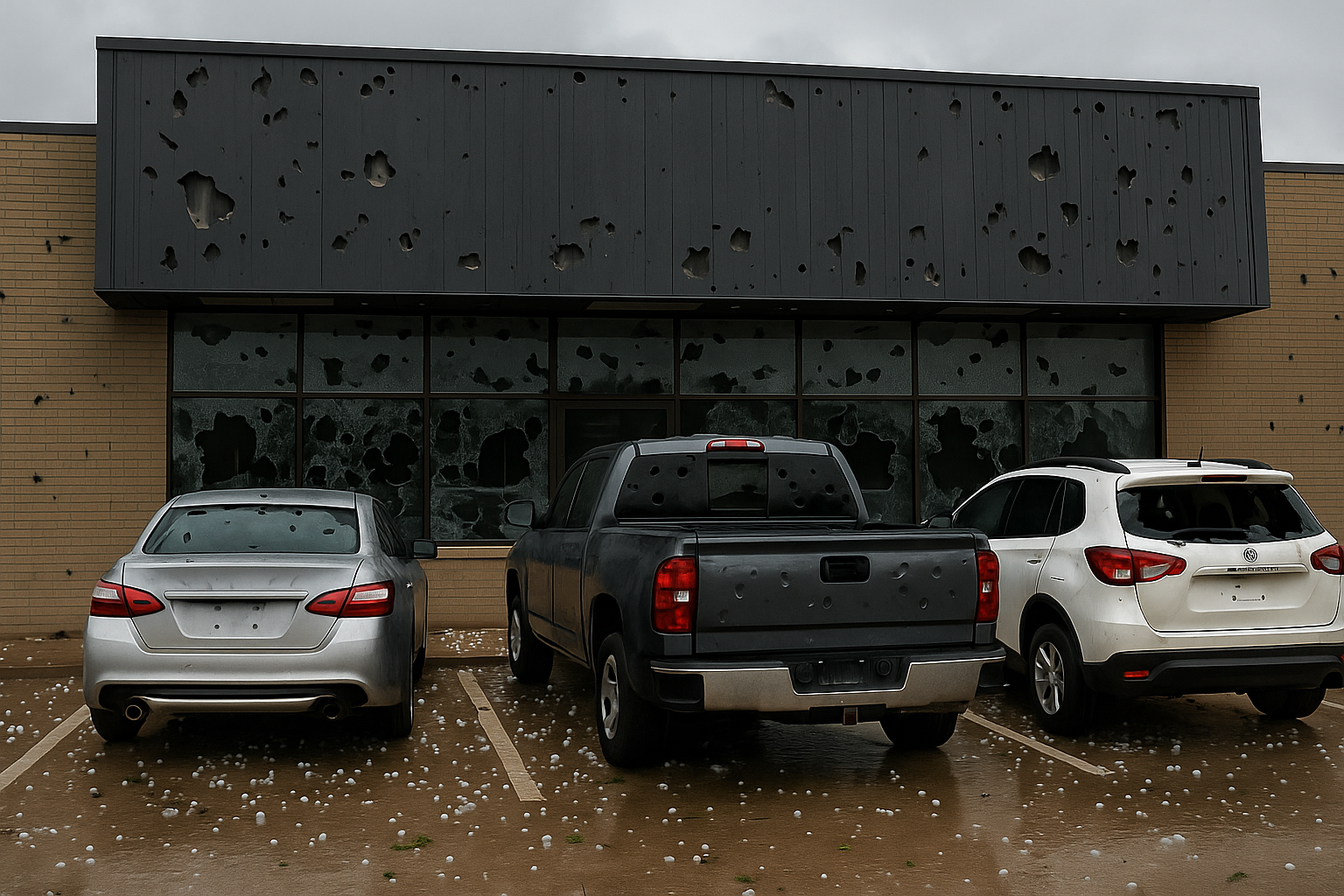When Hail Hits: What Businesses Face & How to Recover
Updated
July 24, 2025
•
4
min read

Hailstorms are sudden and fierce – a few minutes can cause weeks or months of fallout. For businesses, the stakes include damaged assets, disrupted operations, insurance challenges, and shaken customer confidence.
And the losses from hail damage are growing. In 2024 alone, State Farm customers nationwide experienced property damage from severe hail, leading this single insurer to pay out more than $3.8 billion for home repairs and over $1.2 billion for auto repairs. Source: State Farm
1. The Immediate Impact
Property and asset damage
- Vehicles, exterior signage, lot lighting, and outdoor inventory often take the brunt. Even small stones (1" in diameter) can shatter windshields, dent panels, and destroy high-value inventory.
- Outdoor dealerships and open parking lots are especially vulnerable, with hail exposing every single unit in inventory to potential loss. Covered protection is rare, and high-volume lots often have no place to quickly relocate vehicles. A single storm can wipe out millions in auto inventory, and buyers frequently reject repaired vehicles due to perceived value loss.
Safety hazards and injuries
- Flying hail can break glass and injure employees or customers if caught outside.
Operational disruption
- Immediate shutdowns are likely needed to ensure safety, assess damage, and initiate recovery protocols.
2. Broad Business Disruption
Operational downtime
- Repairing damaged vehicles, glass, and property takes time—and halts normal operations. The insurance claims process itself - getting claims in and damage assessed – takes at least a few weeks. After that the repair process starts. Most businesses are at a standstill during this time.
- Staff disruptions: For auto dealers, technicians are instantly reallocated to staging and moving hail-damaged vehicles, derailing routine maintenance. For other businesses staff are at a standstill or shifting focus to deal with the aftermath of hail damage instead of day-to-day business and sales growth.
- Customer frustration: Clients are upset their cars were hit while in service; custom vehicle orders or special inventory orders may be abandoned if hail damage occurs.
Insurance friction
- Filing claims requires thorough damage documentation and can involve long waits or disputes. Some businesses engage a public adjuster to maximize coverage. Source: Mission PLC
Reputation & customer trust
- Disrupted service, delayed deliveries, or lost inventory harm credibility and future sales opportunities.
3. Recovery Roadmap: How to Bounce Back
Preparation—Before the Storm Hits
- Risk assessment: Identify most vulnerable assets—vehicles, outdoor inventory, lighting, signage.
- Backup & protection: Digitally back up business data; install hail-resistant lighting, offer covered storage where possible.
- Monitoring + communication plan: Use real-time weather alerts; notify staff, customers, and suppliers.
- Training & drills: Ensure every team—techs, service, sales, managers—knows roles in storm response.
Source: Minico
B. Immediate Response—During the Storm
- Activate crisis protocols: move vehicles under hail protection if possible, clear walkways, shut down power to vulnerable systems.
- Ensure staff and customers are in designated safe zones.
Source: National General
C. Recovery—After the Storm
- Document damage: photos, videos, VIN-level inventory logs for all vehicles and assets.
- Prioritize repairs: patch windows, secure damaged vehicles, begin contractor scheduling.
- File timely insurance claims with documentation; consider public adjusters or parametric options.
- Restore operations and update customers on delays or temporary limitations.
Source: Mission PLC
D. Long-Term Resilience
- Invest in hail protection systems like hail netting, hail-resistant signage, and improved drainage on lots. Proactive hail protection can lower insurance premiums as well as prevent damage. Source: Hail No
- Periodically reassess insurance coverage to account for higher risks and rising costs or evaluate parametric insurance that pays automatically based on storm severity. Source: Descartes Underwriting
4. Why Proactive Planning Pays Off
- Faster recovery & reduced downtime = higher resilience and less revenue loss
- Improved insurance outcomes = lower premiums, better documentation, faster claims
- Safeguarded reputation & customer trust = clearer communication during downtime, less damage with proactive hail protection systems
- Stronger staff morale = trained teams know what to do under pressure
Key Takeaway
Hailstorms are unpredictable—but your response doesn’t have to be.
By understanding the full scope of business impact—from property damage to customer and staff fallout—companies can prepare smarter. When preparation meets action, hail becomes a manageable event, not a crisis. Businesses that shift from reaction to prevention don’t merely weather the storm; they emerge stronger for it.
Prepare for the Next Hailstorm
Contact Hail No today for a customized quote and see how easy it is to get started.